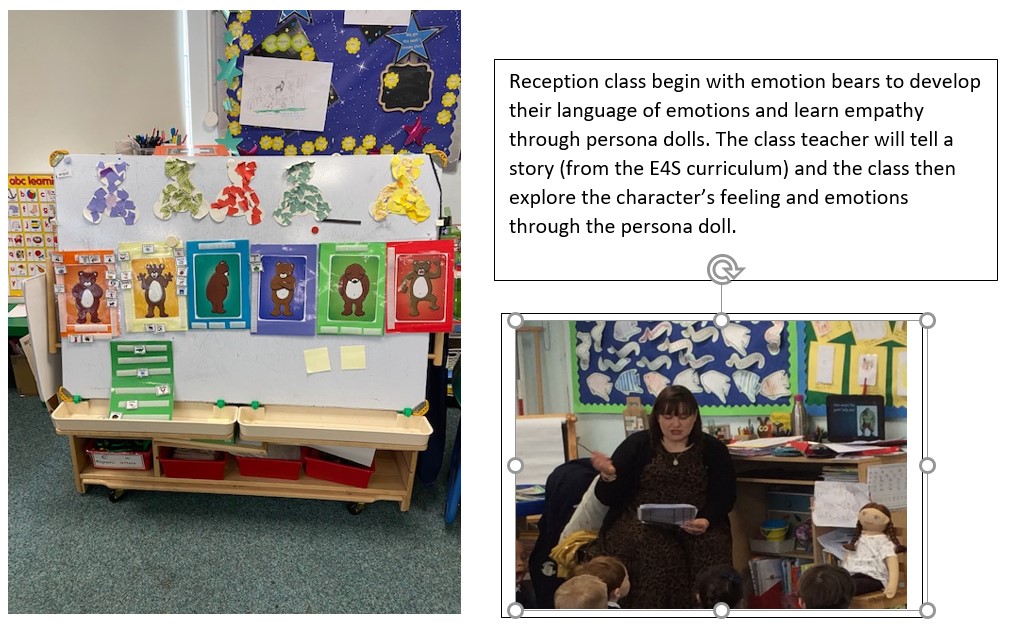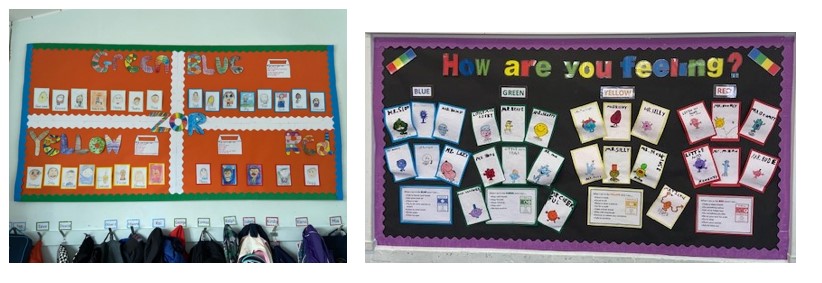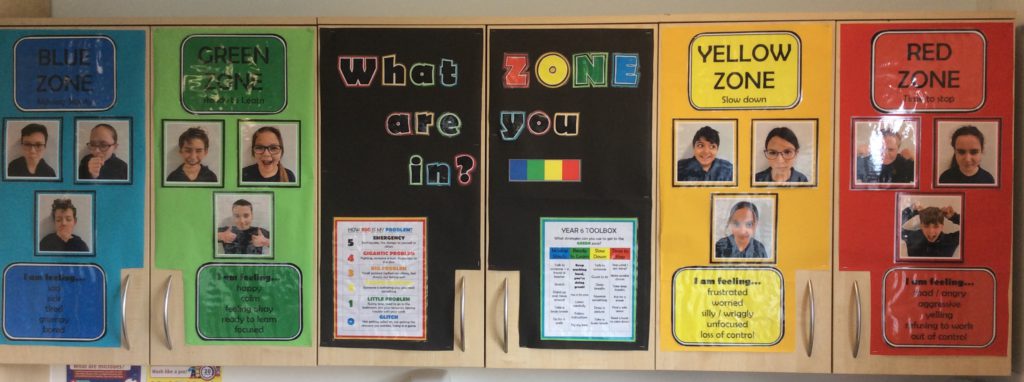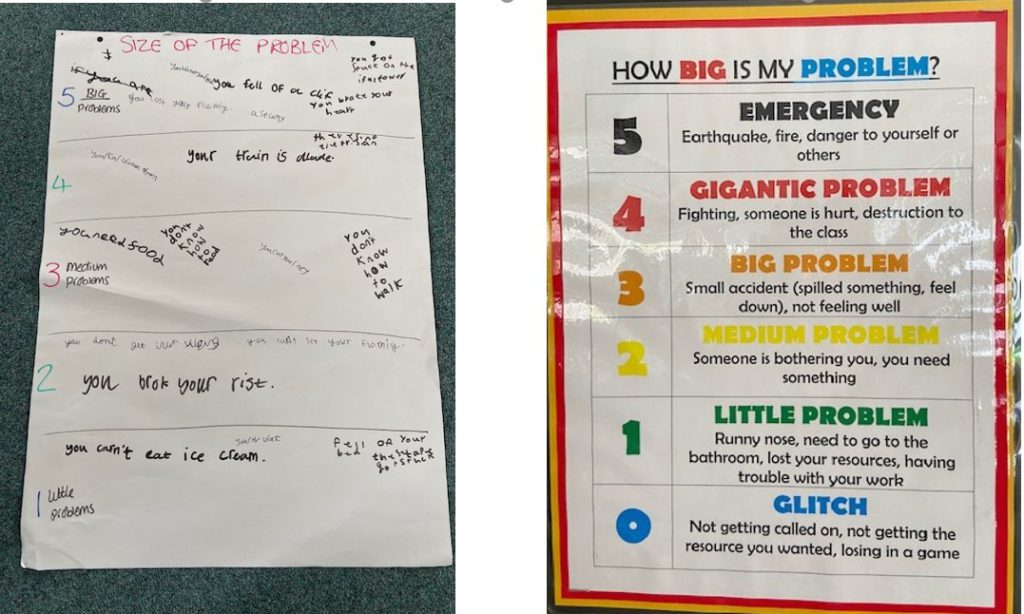Using ‘Zones of Regulation’ to develop social and emotional wellbeing and self awareness

This celebration was nominated by a SEND and Inclusion Link Adviser who described the school senior leadership team as
“…incredibly committed to the needs of all the pupils, they are well over the 3% of pupils with EHCP and they are passionate about including all pupils from their community, despite space and financial pressures.”
Context
St Peter’s Catholic Primary School is situated near the centre of Shoreham. It is a single from entry school for children aged 4-11. St Peter’s is a voluntary aided school which means they are a state-funded school and the Diocese of Arundel & Brighton contributes to building costs and has an influence on the running of the school. The focus of this celebration is on how the Head Teacher and Inclusion Manager have led the school in revising their behaviour policy and whole school approach to supporting pupils’ emotional regulation. This was largely achieved through embedding the Zones of Regulation programme across the whole school, enhanced by resources from Beacon House. The Deputy Head has also ensured that the Zones approach is embedded in their whole school Education for Safety (E4S) curriculum. This WSCC E4S curriculum is delivered across the school every week alongside weekly Zones of Regulation lessons.
Good Practice Explained
The Inclusion Manager explains how they have developed a whole school approach to embedding the Zones of Regulation programme:
Why use Zones of Regulation?
At St Peter’s, we were first introduced to the Zones of Regulation by the Learning Behaviour Advisory Team (LBAT) and used it successfully with individuals for emotional regulation.
Over time, it became apparent that many children across the school, not just those with an additional need, lacked the ability to talk about their emotional state or self-regulate and this was affecting readiness to learn. We concluded our behaviour system felt outdated. It only really worked well for compliant children and we needed something to develop long-term improvements in behaviour and emotional wellbeing.
In September 2020, we took the decision to roll out the use of The Zones of Regulation as a whole school approach. This has helped us to develop a common language and systems across the school through which to discuss and explore emotions, regulation and subsequent behaviours.
What we did
In September 2020, we delivered our own staff INSET on The Zones and explored the resource alongside updating our behaviour policy as a whole staff. It was agreed that all classes would start each Monday morning with a PHSE lesson and reflect on this each Friday. (See staff INSET training download)
Teachers implemented the planned lessons in Years 1- 6, adapting content appropriately, in line with their cohort’s age and stage of development. Some individuals and small groups also continued to work more intensively with the materials to support their particular needs. As classes worked through the lessons, teacher and pupil skills and tools slowly evolved and became part of our daily general classroom practice. This gradual development has been key in embedding The Zones as a framework to work within rather than a short-term solution or resource. Consistency has also been key with established clear expectations across the school for the use of visuals, displays and strategies.
The Zones of Regulation visual displays are tailored to each class:



Working collaboratively with parents has also contributed to the success of the Zones in school. We delivered a parent training session and when appropriate send resources home with our pupils.“



The Head Teacher concludes:
“Since implementing our whole school Zones of Regulation programme, all staff have shown an increased understanding of allowing time to self-regulate/de-escalate. With our graduated approach to dysregulated children, staff understand that they need to give additional time to allow children to begin to regulate. With this approach we have seen a significant reduction in escalating behaviours as children learn strategies to manage their emotional states and stay safe”.
Hear what the St Peter’s pupils and staff about the Zones in their school by watching the video.
The St Peter’s Team have seen the following impact:
- Pupils are more able to recognise their emotional state at a given time (zone) and how to change or stay in the zone they are in, taking control of their behaviour and learning.
- Emotional vocabulary has increased, so pupils can explain how they are feeling using a common language.
- Pupils have a greater insight into triggers that might make them move into the different Zones.
- All members of the school understand that emotions, sensory experiences, physiological needs and environments can influence behaviour and readiness to learn.
- Pupils have developed their own problem-solving skills.
- All pupils have access to a range of calming and alerting strategies/tools that support them.
- Behaviour for learning accountability has transferred onto children for managing their own behaviour, instead of a behaviour management system being ‘applied to them’.
- Has explicitly taught the skills of self-regulation: self-control, resilience, anger management, impulse control and sensory regulation.
- There has been a significant reduction in fixed term exclusions.
“We started using ‘zones’ at home with our son during lockdown. The online lessons were really helpful and it was good exploring it together. It really helps having the visuals from school – and is so powerful the whole family is now using it!”
Parent
The Staff at St Peter’s have positive things to say too:
“Tracking children’s feelings throughout the day and being able to intervene more quickly has benefited learning, especially for children of a more introverted nature.”
Year 4 teacher
“Using the Zones of Regulation has enabled us to appreciate just how important it is to teach children about feelings. Just because a child is experiencing an emotion, it doesn’t automatically follow that they understand the cause of it and how to respond. We have found that by teaching children about emotions more explicitly, they are in better control of their mood. They are able to have more ownership of their behaviour and this has had a positive impact across the school.”
Headteacher
“The Zones of Regulation has been invaluable as they have helped children to be able to begin to identify their feelings, triggers and ways in which to regulate them.”
Year 6 teacher
“The zones fits naturally in with our E4S curriculum and have become an effective tool for monitoring wellbeing and supporting children to manage their behaviour.”
Deputy head
“It has been great to see all staff, pupils and parents embracing the Zones of Regulation with the language and tools becoming part of everyday life in school and at home. All children having access to zones as part of their daily routine means that individuals who may need to use their toolkits daily do not feel singled out or different to their peers.”
SENCo
Top Tips from St Peter’s Catholic Primary School for other schools
- Involve the whole school – teachers, teaching assistants, children, support staff and parents to embed the approach and use of language into the day to day running of the school.
- Systematically work through the planned lessons to ensure emotional states and regulation techniques are fully unpicked with children at an appropriate level.
- Adults regularly modelling the zone they are in and what they can do to move out if it emphasises the use of this as a whole school tool and not a system purely for behaviour management of pupils.
- Regularly review what is going well and what is not working so well in staff and/or key stage meetings.
- Embed consistent expectations across the school for visuals and the use of tools.
- Ensure Behaviour Policy is updated alongside implementation to ensure common expectations and systems are in place.
Links to the West Sussex Inclusion Framework
We can see clear links to two areas of the inclusion framework:
2.2 Policies
- Policies are documents which are reflected in observable practice of the school and its routines.
Specifically:
- The school’s inclusive vision and aims are reflected in all policies. Policies are easily accessible and available in a range of appropriate formats.
- All CYP, parents, staff and governors have access to relevant policies and can describe their effective implementation – they find them supportive and can provide examples where the policies have had a positive impact.
Within Aspect 3: Personal Development, Wellbeing and Welfare of Children, Young People and Staff
3.1 Social and emotional well-being and self-awareness
- There is an open and supportive atmosphere that promotes self-awareness and allows children and young people (CYP) and staff to reflect on their own emotional needs and triggers.
- Staff and CYP well-being are promoted and supported allowing them to flourish.
- CYP are given opportunities to share their feelings and emotions and these are acted upon by the adults within school.
- The school curriculum is reflective of CYP needs and provides a universal curriculum for all CYP to develop all areas of social and emotional well-being and self-awareness.
Specifically:
- Staff at all levels understand CYP’s behaviour in context, in terms of communicating or attempting to address unmet needs. Staff understand their role in co-regulating and developing CYP’s capacity to become independent, regulate their emotions and manage their behaviours effectively.
- Staff audit the learning environment on a regular basis, ideally with parents and CYP, to explore how it meets the needs. The planning of the environment takes account of the triggers for CYP. Adjustments are made to the interior and exterior environment to make it accessible e.g. sensory garden/ low arousal spaces. Staff try to see the world through the CYP’s eyes and really listen to their experience, even though they may not truly understand exactly how this feels.
- The setting has activities that are well organised, structured and planned for. Where possible, advanced warning is given, to both CYP and parent, of any changes to familiar routines in a meaningful and helpful way, particularly to those with neuro diverse needs.
- Strategies to support CYP’s social and emotional needs, including those derived from a therapeutic thinking approach, are embedded within the classroom and used consistently across the school. CYP see these tools and structures as useful and purposeful tools. CYP’s needs are met such that they can remain in the classroom and learn effectively.
- Staff do not assume CYP understand the language of emotions so use scaffolds to support their understanding and use language that supports co-regulation.
- Staff understand the link between emotional regulation and readiness to learn and refer to the special educational needs co-ordinator (SENCO) when concerns arise.
- Staff are aware of the risk factors for CYP in response to life events and at times of crisis that might contribute to social, emotional and mental health difficulties, e.g. trauma, Adverse Childhood Experiences, sensory dysregulation and attachment issues.
- A whole school approach to Education for Safeguarding (such as WSCC E4S) is clearly evident and facilitation of learning is effective in meeting the needs of the school community.
- The school works with parents to support the child’s emotional well-being, this is reflected within the school’s Relationship and Health or Relationship, Sex and Health Education (RSHE) and wider Education for Safeguarding curriculum (please refer to WSCC E4S) in line with statutory guidance.
3.3 A safe place to be
- The school works proactively with all children and young people (CYP) and their parent carers, to explore their experiences around school, their learning and to positively address sensitive areas.
Specifically:
- All safeguarding procedures are clearly reflected in school policies and are fully compliant with ‘Keeping Children Safe In Education (KCSIE).‘ The needs of disadvantaged children and those with special educational needs and disabilities (SEND) are specifically considered and effectively included in safeguarding policies and procedures. All staff are aware of the local services available to assist CYP and their families.
- A whole school approach to Education for Safeguarding (E4S) is clearly evident and facilitation of learning is effective in meeting the needs of the school community.
- All staff can confidently describe their roles and responsibilities in relation to behaviour, attendance, exclusions and anti-bullying, and how it impacts on CYP’s outcomes.
- CYP from all groups report that their experience of school is positive, supportive and safe. There are opportunities for peer support such as playground buddies, peer mediators and peer mentors. Staff are insightful and can spot power imbalances in friendships, that may be based on subtle differences that the more vulnerable CYP isn’t aware of. These instances are used to allow the more “powerful” CYP a chance to reflect and learn other ways of interacting.
- The school can provide a range of examples where creative and imaginative learning opportunities have assisted the CYP with SEND, additional needs or from disadvantaged groups to feel safe and achieve well. These CYP are routinely asked what vehicles they find useful in furthering their learning and engagement.
- There are designated calm, safe spaces within the school and school grounds. These have been identified with and can be used by the CYP to self-regulate when needed.
- Safe places and routines are identified within individual support plans for those who need support to maintain their emotional regulation.
- CYP are encouraged to know how to access support mechanisms that exist outside of school, such as national helplines.
- CYP can describe how they have helped to shape systems to report bullying (including when it occurs online), and how they play an active role in combating bullying and supporting those who have been targets of bullying.
- There is a system for CYP and staff to report incidents of bullying, including confidential listening opportunities. CYP know who to speak to when they do not feel safe and report that action is taken: observations of CYP around school and discussions with CYP confirm this. The school consistently counters all forms of discrimination.
- Interventions and support ensure that all CYP involved in alleged incidents remain safe throughout all stages of investigation through to resolution. Support is provided for both the victims and perpetrators of bullying behaviours with a clear plan on how this is managed across the school to avoid future incidents.
3.4 Behaviour policy and procedures
- The school balances the need for consistent implementation of behaviour policies with the need to make reasonable adjustments to meet the needs of individuals and the Equalities Act 2010.
Specifically:
- Behaviour policies are personal to the school and reflects its uniqueness and provision. It encourages pro-social behaviours and allows for a range of approaches tailored to specific children and young people’s (CYP’s) needs and circumstances.
- Staff, parents and CYP evaluate the impact of behaviour policies at a developmentally appropriate level. They can discuss positive and negative outcomes and can describe adaptations that have been made as a result.
- Consideration should be made to discuss behaviour policy and any behaviour incidents or sanctions with parents who use English as an additional language, to ensure thorough understanding of procedures.
- Staff are trained in appropriate de-escalation approaches. When de-escalation techniques are implemented, behaviour incidences are effectively recorded and analysed, and individual plans are updated.
- All staff remain professional, are trained in and use restorative techniques in the face of all behaviours. Staff strive to identify the need communicated by the CYP’s behaviour and endeavour to meet that need.
- There are opportunities to explore recent developments in neuroscience, see SEND Toolkit, and its links to brain development, the stress system and trauma. Staff can link this to practice and policies that support emotional regulation and de-escalation.
- All staff use creative restorative approaches to resolve conflict or re-engage those returning to school. CYP facilitate restorative approaches with their peers.
- Fixed-term and internal exclusions are only used when appropriate. Excluded CYP are effectively supported to make a timely reintegration back into school. Permanent exclusion is only used as a last resort.
- Physical intervention is rarely used. Staff know that this can be particularly difficult for CYP with needs such as autism, and staff understand the legal framework of positive handling intervention to respond in a safe and appropriate way when managing behaviours that challenge. If physical restraint is used, staff are well trained, competent and supported. All incidents are accurately recorded, reported to parents and scrutinised by a senior member of staff not involved in the intervention.
Last updated 24 November 2022
 Tools for Schools
Tools for Schools